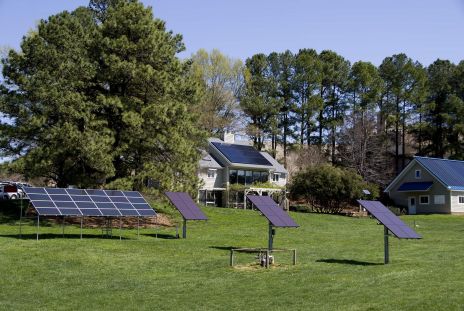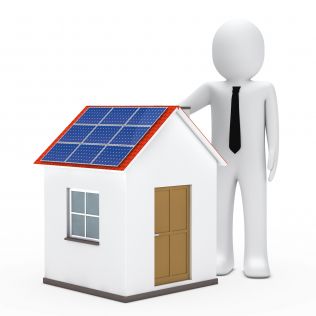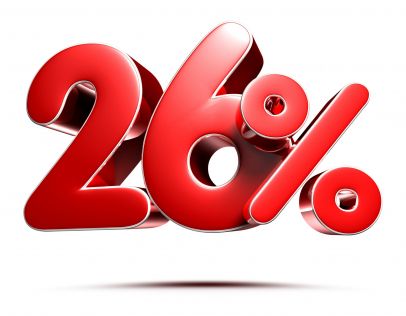Solar Panel Cost Per Watt | Solar Panels Cost New Jersey
What does a solar panel cost per watt?
To calculate a price per panel for new solar energy or photovoltaic system, a homeowner should determine the size of the system and the costs to mount solar panels. A typical residential solar energy or solar panel system is about 5 kW in size. A calculator can be used to determine the number and the per watt cost of panels needed for a specific house. From there, an installer can give you installation prices.
Average solar panel price per watt
Solar panels range in price from $0.70 to $1.50 per watt, although the cost of solar power might differ significantly depending on where you live and how much energy your home uses. On average, a 250-watt solar panel costs around $175 to $375. The typical homeowner spends between $3,910 and $6,490. Installing solar panels typically costs between $15,000 and $25,000.
Cost of Solar Panels By Type
Monocrystalline Solar Panels
Monocrystalline solar panels are the most expensive. They have been around for over 20 years and have a high conversion efficiency, utilizing more of the sun’s energy to produce electricity than other types of cells. The name ‘mono’ means one, and ‘crystal’ refers to the cell structure. They are made entirely of silicon. These cells are more challenging to manufacture, which is why they cost more. Monocrystalline panels range in price from $1 to $1.50 per watt.

Polycrystalline Solar Panels
Polycrystalline solar panels are less expensive than monocrystalline. ‘Poly’ means multiple, so these cells are made of silicon crystals melted together to form one cell. These cells are created by pouring liquid silicon into a square mold and spinning it until the silicon hardens and cools to form a perfect square. These cells range in price from $0.90 to $1 per watt.
Thin-Film Solar Panels
Thin-film solar panels are the least expensive but also less efficient than other panel types. Thin-film refers to the cell structure, which is deposited on top of glass or another substrate material. This cell structure comprises several layers that include electrodes, transport layers, and photoactive semiconductor materials. Thin-film cells are mainly used in smaller consumer products like computers and calculators. The price ranges from $0 to $1 per solar PV panel.
Factors that contribute to the solar panel costs
Types of solar panel systems
The cost of solar panels per watt depends on the type of solar panel system you have. A residential solar system is most common, which can give energy to your home and save you a lot in energy costs. Commercial solar PV systems are more extensive and usually designed for companies. Both residential and commercial solar systems can be purchased with batteries for backup.
A photovoltaic (PV) solar system includes solar panels, inverters, wires, and other materials needed to convert solar energy into electrical current or a direct-current voltage that your household appliances can use.
The type of panels is an important factor in the cost of solar power as some are better for specific geographic locations than others.
Location
The cost of solar panels also depends on where you live. The average price of solar power varies by state, with Hawaii being the most expensive the average solar panel cost and their installation is $3.38 per watt, and the average solar panel cost in Arizona is $2.49 per watt. Other factors that contribute to the price are local utility rates, incentives available for going green, and the availability of solar panels.
System size
The size of your solar panel system will also affect the cost. Larger solar systems are more expensive because they require more materials and equipment for installation. In addition, an extensive system produces enough electricity to power an entire house or building, which requires fewer panels than a smaller solar panel system that supplies a portion of the home’s energy needs.
Type of inverter
The type of inverter your system uses also affects the cost, as well as its efficiency. Inverters convert DC power from solar panels to AC power that can be used in your home or business. Grid-tied inverters are the most common type of inverter. Grid-tied inverters are considered on the grid because they connect to your utility provider’s power lines for backup if needed, and off the grid because you can disconnect from the grid during an outage. Grid-tied inverters produce AC power and help integrate the solar energy system with your utility service. When using a grid tie inverter, you may not be able to completely disconnect from the grid during blackouts because it provides backup power to your home or business.
Battery backup
Homeowners who are looking to cut their electricity bills by using less power generated by the electric company may also want a solar panel system with battery backup. A battery backup system functions as an emergency supply of energy during power outages, which adds to the cost of solar panels for homes.
What is the cost to install solar panels for an average 2,500 square foot home today?
A solar panel installation for an average 2,500 square foot home will cost about $11,900 – $14,875. Presently, the average solar cost is about $2.76 per panel. Solar Installation costs vary by location and type of installation. It is best to get multiple quotes from a different contractor and compare the costs and services before pursuing the solar installation project.
The average cost will also depend on the size of the solar panel installation. Some homeowners install solar panels anywhere from 100 to 300 solar panels, while some choose to install thousands.
Solar panel costs are divided into three parts: installation, maintenance, and other costs. Solar panels use energy from sunlight to produce electricity. The size of the solar array will determine how many panels are needed to replace a household’s usage with solar power. The cost of these panels varies based on where you live and what type you purchase.
Typically a small home solar panel system is about 4-5 Kw (5000 watts) which can run all your appliances at once, but not an electric oven or central air conditioner. Usually, it takes two or more solar systems wired in parallel for those items as well as heating water, depending on hot water fuel source as well as climate zone.
The average 2,500 square foot home would require about – 14 KW of power or 14,000 watts of solar panels to completely power a home. Due to the size of an average 2,500 square foot home, one would require about 265 solar panels which will cover both roof and surface area.
Installation costs vary based on how difficult it is to access the installation site and whether there are permitting regulations that need to be met before installing a system. Many cities offer a rebate program if you choose a qualified contractor in their jurisdiction that has been vetted by their standards licensing department for quality assurance.
Solar kits are designed for homeowners who would like to install the panels themselves. Solar kit prices vary by system size, but they are usually less expensive than hiring a contractor to install solar panels.
Financing Options
There are various financing options available to buy solar panels, including loans and leasing. Loans let you own your solar panel system at the end of the agreement while leasing means that you rent the system from a third-party provider for usually ten years or more. Leasing allows homeowners to use clean energy without extra cash upfront because providers typically pay for all of the up-front expenses—the solar panels, installation, permits, and maintenance are included in the monthly lease payment. Lenders, such as banks and credit unions, offer loans to customers who may not have the cash or can’t afford a large down payment.

Whether you choose a loan or leasing agreement, your provider will likely ask for down payment upfront to secure your commitment. Don’t be taken aback by this request because it is typical in these types of dealings. Keep in mind that your provider will pay thousands of dollars for equipment and installation work, which you repay as part of the monthly payment over a while. You can start saving money right away on those monthly payments (and save some energy as well).
When deciding between loans and leasing as financing options, consider how long you plan on staying in your home and how much money you can afford each month. If you plan on selling your house in a few years, consider the possibility of selling the solar panel system with it. A leasing agreement is ideal for homeowners who want to save money over time or do not have extra cash lying around because monthly payments are lower than loans. Homeowners that plan on staying put for the long run find loans to be more advantageous.
Solar Power Purchase Agreements
In all 50 states, homeowners and businesses can take advantage of solar power purchase agreements (PPA). In this type of agreement, a 3rd party will install the system on your property at no cost to you. You then purchase the energy and in most cases, can lock in a rate for 20 years or more. The 3rd party is responsible for maintenance, repairs, and insurance. The only cost to you is the monthly utility bill if you don’t use all of your solar energy or excess credits at the end of each month.
Solar Subsidies
The incentive to go solar has significantly dropped in recent years due to lower equipment prices and increased availability. In some states, the government offers direct incentives from an energy fund. This is often in the form of money or solar renewable energy certificates (SRECs) and can pay up to 50% or more of your solar system cost.
Tax Exemption
A solar tax exemption is the complete removal of an item from your taxable income. The tax exemption for solar power is not immediate. You will need to wait until the next time you file your taxes to take advantage of the tax break. Once installed, your system’s output will be calculated over a period of years, and depending on how much electricity it generates, you can claim that amount as a tax deduction each year until its value has been exhausted or it has reached the end of its useful lifetime.
Federal Solar Tax Credits and State Solar Incentives
Federal Solar Tax Credit
The federal government offers 26% solar tax credits for Americans who purchase and install solar panels. This solar tax credit incentive can significantly lower the cost. The federal solar tax credit is a dollar-for-dollar reduction in the amount of income tax you would otherwise owe.

The federal solar tax credit was set to expire at the end of 2016 but has been renewed and is in place through 2021. The amount that your home or business will receive a tax credit depends on certain factors such as your tax liability, the year in which it is installed, and the type of equipment purchased.
State Solar Tax Credit
An additional state tax solar credit is offered in 50 states. These are not dollar-for-dollar reductions of your income tax liability but can be an absolute dollar amount or percentage based on the cost of the solar panel system. The state tax solar credit is also an incentive that can lower the cost of your new solar panel system. Tax exemption, rebates, and solar tax credit are just a few of the available incentives that you can use to reduce the price of going solar.
Pros of Solar Leasing
Leasing solar panel has several advantages that are inherent to the technology.
- There are no upfront expenses associated with solar panel installation.
- Not only can you lock in energy rates for the long run, but doing so now may help you avoid the cost of a price increase later.
- Avoid the aggravation of equipment maintenance and monitoring.
- Solar panels save you a lot of money on your utility bill.
- Reduced household carbon footprint
- Payments in solar leases are reduced if the panel doesn’t generate as anticipated, lowering the danger of losing money.
Cons of Solar Leasing
However, there are certain difficulties with leasing solar panels that may deter some people from entering into this market:
- Utility costs per watt of solar panel are rising, and the leasing price is increasing each year. Expected savings in cost might be undercut by this factor.
- Because you don’t own solar panels, you are not eligible for the federal solar tax credit or local incentives.
- Although there is no upfront expenditure, over the system’s lifetime, you will almost certainly spend a greater amount than you would have if you bought the solar panels separately.
- Leased solar panels do not add value to your home, as they are not a part of the property you own.
Frequently asked questions
Q. How much does the average solar panels cost per watt?
A. The average cost per watt for residential solar panel installations is around $2.50 to $3.50 per watt, but this varies depending on what you need.
Solar panels cost more in high-demand areas of the country. And more efficient (and therefore pricier) panels will save you money on electric bills more quickly but might cost you more upfront.
Q. What is the cheapest cost of solar panel?
A. The cheapest solar panel cost per watt is $0.70 per watt based on average panel costs in the US. The per-watt cost of solar panels varies depending on location. In certain markets, such as California and Texas, solar PV panels are more efficient and less expensive than in many other areas.
Solar panels cost, on average, about $6.50 per watt in the US and roughly double that amount globally.
Q. What is the price of a photovoltaic solar panel?
A. A Solar panel can be purchased in several ways: depending on the type and size, they usually cost about $2.76 /watt installed for standard crystalline silicon residential modules. This estimation doesn’t count any other solar equipment necessary, such as inverters and mounting systems. The price per watt of a solar panel can vary a lot, depending on the brand and type. Solar inverters and solar batteries are usually the same, but there are some differences between manufacturers. Incentives and rebates can also change the price of a solar panel.
Q: How much do solar panels cost for a 2,000 square foot house?
This also depends on where you are located, what power they put out, and how many solar panels you need. The average cost for a 2,000 square foot house is between $9,520 – $11,900. You can also check with your local government to see what rebates they might offer.
Residential solar energy costs $0.08 to $0.10 per kWh on average, and commercial or utility-scale solar power costs $0.06 to $0.08 per kWh.
Q: What is Driving the Declining Cost of Solar Power?
A: The exponential growth in solar panel installation has been a key influencer in lowering the cost of solar power throughout the previous decade. Solar power has seen an average yearly growth rate of 49%, which is known as the “economy of scale.” The price of solar panels fell about 15-20% for every doubling in scale. The solar cost has been declining at a rate of about 10% every year.
Q: How do you pay for a solar panel installation?
A: Once you know the cost of solar for your unique project, it’s time to decide how you’ll pay for solar. There are three primary ways to finance a solar panel installation: a cash purchase, a solar loan, or a solar lease/power purchase agreement.
When To Install Solar Panels
Contrary to popular belief, winter is the ideal time to install solar panels. In winter, there is significantly less demand for this service, so the overall cost of solar panel installation should be lower. Even if you live in a region that is cloudy, your solar panels will be able to generate power, and in some cases, more energy than they would produce during the summer months.
Solar panel cost has declined significantly since 2008 when a federal solar tax credit was first introduced for going solar, but this has been offset by rising raw material prices. The solar panel cost is expected to decline as economies of scale increase further, as well as.
Installing solar panels on your home can help you save money on electricity costs each month, but the upfront cost is significant. For the most part, the higher the wattage or strength of your solar panel, the higher its cost per solar panel will be. For this reason, solar panels are often sold in bulk for a reduced rate. As the overall cost of solar has been steadily decreasing over the years, more people have been drawn to going green by making their homes run on solar power.
